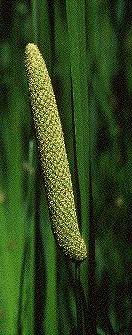

Sweet flag has long been known for its medicinal value, and has been cultivated in Asia for this reason. The species Acorus calamus is native to the southeastern United States, growing in wet areas in marshes and ditches. It looks rather grass-like, until closer inspection reveals the arum-like cluster of flowers (the spadix), visible in the picture at right.
Acorus is a rather remarkable plant in a number of respects. Until recently, it was just another arum among others, in one of the larger and more complicated monocot families. Upon investigation of its morphology and its DNA sequences, it now appears that Acorus may represent an early stage in the evolution of the monocots, since it falls out as their sister group.
Because this is such a small group (only one genus), it is not surprising that the fossil record is poorly known. W. L. Crepet has identified some Eocene spadices from Tennessee as belonging to this group. The preservation is good enough to reveal details of the cuticular and floral anatomy, both of which are consistent with modern Acorus. The fossils have been named Acorites heeri. Despite its sparse fossil record, the group has great importance for paleontologists, in that it gives us one picture of what early monocots may have looked like, and where they may have lived.
For more information about Acorus, try the DELTA description of the Acoraceae.
There is also a site on the medicinal uses of Acorus calamus, with notes on the personal experiences of the author.

Sources:
W. L. Crepet. 1978. Investigations of angiosperms from the Eocene of North
America: an aroid inflorescence. Rev. Palaeobot. Palynol. 25: 241-252.
M. R. Duvall, et al., 1993. Phylogenetic hypotheses for the monocotyledons constructed from rbcL sequence data. Ann. Missouri Bot. Gard. 80: 607-619.

